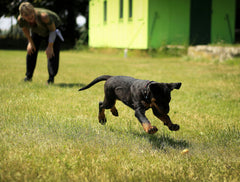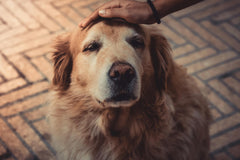
How in 40 years, what was once just a game has become the most practiced discipline in the world.
The success of agility is still going strong year after year. Nothing seems to be able to hinder the progression of what was initially only a demonstration, a show to entertain the exhibitors and spectators of the Crufts.It all started in 1977. To make the next National Show of the British Kennel Club more enjoyable, a few friends, led by Peter Lewis, imagined an entertaining course for the dogs and their masters and pleasant to watch for everyone, experienced or novice dog-lovers alike. There were also different kinds of dog agility classes.
Between two podiums that only interest connoisseurs, dogs turn, jump and turn in a ring. And in joy. A show. Dare to compare: like cheerleaders at halftime in NBA basketball games! But we're at this very select show in London called Crufts. There's a lot of people and a lot of media. It's John Varley, member of the Crufts organizing committee, who wanted to bring a little... variety to the show.
Agility shows up at the right time, in the right place and gets an unexpected and unhoped-for success. Peter Lewis and his friends are invited to come back the following year. They come back with a slightly more elaborate program. And from 1980, it is an agility competition which is proposed within the framework of Crufts. The intention of the inventors of this discipline was not to promote it. Nor was it their ambition to create a new selection discipline. But they achieved goals they hadn't set for themselves and achieved success they hadn't even imagined...
Born in England, agility was soon exported. Today it is practiced in all countries that have an organized canine sport.
After the English who shot first, the French did not take long to start agility. Clubs of use bloom a little everywhere. It is in these clubs and nowhere else that what everyone still calls "dressage" is practiced and taught. The clubs have only the ring, the Schutzhund and the tracking to offer to their members who are tempted by competition. But these are demanding disciplines that are not accessible to all breeds and subjects. So, we practice biting, tracking, obedience too, at least the obedience part of the ring or the Schutzhund because it is a good thing, even for dogs that don't bite, to learn the rudiments of dog education or sport: walking on a leash, absence of the master, retrieving objects, jumps, etc..
Promoted to keep and occupy a part of the members of the clubs, agility will make its "hole" there.
We are in 1986. Royal Canin offers a dog agility course to clubs that have the structures and the organizers to launch the discipline. It is pure and hard marketing: a dog that moves is better and eats more...
At the beginning of 1988, with a few judges and already a lot of people practicing, the discipline was launched all over Europe and the United States. It will if not crowd out, at least slow down the expansion of all the others. At the same time, the French ring is trying to make a breakthrough in the United States, Canada, Morocco, Spain...
Without ever succeeding to the level of the efforts of those who tried to promote it. Agility on the other hand, starts strong and will know a perennial expansion in Europe.
Selection
On October 1, 1989, the International Canine Federation met in Strasbourg and appointed the Frenchman Jean-Paul Petitdidier president of the new agility commission. It is the beginning of the worldwide development of the discipline. A discipline invented by the English. But it appears that the French were the best promoters.
In 2011, 34 countries are represented. In 2016, all the member countries of the F.C.I. are members of the agility commission. And in countries such as the United States whose dog society or societies are not affiliated to the F.C.I. agility is also increasingly successful.
As Maryannic Jourden, international judge and manager of agility in France, points out, "For many practitioners, agility is a passion and even a way of life. Motorhomes fitted out for the dog(s), dates and holiday destinations programmed according to the competitions and training grounds... This is how many agilitists live".
What started out as an animation for fairs and exhibitions has become a sport. The competitors take care not only of their dog's physical condition but also of their own. What started out as a game, a game accessible to all and open to all breeds has become a selection test, whether we like it or not and although the promoters have always defended it.
Users have observed that border-collie in the big ones and shetlands in the small ones were the most gifted for agility. In category C, Belgian shepherds and Aussies, in category A, poodles and Jackrussell are still serious outsiders. Maryannic Jourden, very attached to the shepherd of the Pyrenees, also set her heart on the border-collie two years ago: "the border-collie very successful in agility training, also show a remarkable intelligence. Agilityists also use them as stallions in the hope of producing subjects that will also be very successful. "They thus take part in a work which one did not ask them: the improvement of the breeds.
The border-collie was already highly appreciated for its qualities as a sheepdog. For the Shetland, which races at the top in category A, agility is a new outlet because the breed was not very popular with the public until five years ago.
Now, even if certain breeds dominate the competitions and consequently win the favors of the practitioners, all are admitted and even welcome. In the industry, discrimination is not allowed. Agility was not a selection event. It has become one anyway, whether we like it or not...
The media coverage of agility has also contributed to its success. It is probably not the only reference, but Wikipedia devotes several pages to this discipline when it ignores the ring, the Schutzhund, the tracking or the hunting events.
TV channels broadcast images of sledding races because they take place in picturesque landscapes and broadcast even more reports on agility. In the eyes of general dog-lovers, and most veterinarians are, there are many dog training events today: agility and others.
It is true that the courses of the champions and even of the others besides are very spectacular and that it is not necessary to be a connoisseur of the dog or the discipline to appreciate. It is also what makes the success of agility. It's nice to see, lively, it enhances the dog. There are joys and disappointments, discussions and polemics too... Finally, nobody gets bored.
Written by my dear friend, Jean-Yves Reguer
How to build a dog agility course?
How to teach your dog agility training?
Can any dogs do agility?
Check out our blog and follow me on LinkedIn to stay up-to-date!




